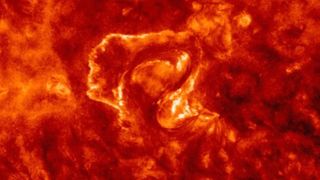Solar maximum news, features and articles
Solar maximum is the most active phase of the sun's roughly 11-year solar cycle, which occurs when our home star's magnetic field weakens and eventually flips completely.
During this explosive peak, dark sunspots cover the solar surface and spit out more frequent and intense solar flares or coronal mass ejections. If these solar storms hit Earth, they can trigger radio blackouts, interfere with satellites, disrupt ground-based infrastructure and paint widespread auroras across the night sky.
Discover more about the solar maximum:
Latest about solar maximum

'The sun is slowly waking up': NASA warns that there may be more extreme space weather for decades to come
By Harry Baker published
A new NASA study suggests that solar activity will remain high or rise further in the coming decades, contradicting previous assumptions that the sun was quieting down — and scientists "don't completely understand" why.

Gigantic 'letter S' spotted on the sun just before a 'dark eruption' hurls a fiery shadow at Earth
By Harry Baker published
A giant S-shape structure, around 10 times wider than Earth, recently appeared in the center of the sun, moments before our home star unleashed an even larger plume of plasma that later crashed into our planet.

'Cannibal' solar storm could paint auroras above 18 US states this Labor Day
By Harry Baker published
Space weather experts warn that a "strong" geomagnetic storm will rock Earth on Sept. 1-2, potentially lighting the skies with vibrant auroras across large parts of North America. The disturbance is being triggered by a rare, cannibalistic ejection from the sun.

Solar tornado rages on the sun as a giant plasma plume erupts
By Patrick Pester published
There's a giant solar tornado raging on the sun's surface, and a researcher captured it — plus a massive plasma eruption — in one spectacular image.

Behold, 'The Beast': Gigantic animal-like plasma plume 13 times wider than Earth hovers over the sun
By Harry Baker published
Astrophotographers have snapped stunning shots of a giant shapeshifting solar prominence, dubbed "The Beast," which appeared over the sun's northeastern limb on July 12 and rained impossibly fast fire over our home star.

Astrophotographer snaps 'once-in-a-lifetime' shot of solar flare photobombing the ISS
By Harry Baker published
An astrophotographer has captured an extremely rare and "difficult" photo of a solar flare exploding from the sun at the exact moment the International Space Station passed directly in front of our home star.

Friday the 13th solar storm could bring auroras to 18 US states this weekend
By Harry Baker published
Space weather experts warn that a "moderate" geomagnetic storm could rock Earth over the weekend, potentially lighting the skies with vibrant auroras across large parts of the U.S. and Europe.

Bottom of the sun becomes visible to humans for the first time in history (photos)
By Brandon Specktor published
For the first time, scientists have imaged the elusive south pole of the sun. The images captured by the Solar Orbiter spacecraft reveal our star's magnetic field is a powder keg ready to blow.

Giant 'senior citizen' sunspot on 3rd trip around the sun could break a century-old record
By Harry Baker published
A large sunspot has just reappeared on the sun's Earth-facing surface, almost two months after it first emerged. The unusually old dark patch remains stable and could be on course to become the longest-lived sunspot on record, experts claim.

A mysterious, 100-year solar cycle may have just restarted
By Harry Baker published
New research suggests that the unexpected intensity of the ongoing solar maximum may be partly tied to a lesser-known, 100-year solar cycle. If true, solar activity could spike further in the coming decades. But some experts are skeptical.
Get the world’s most fascinating discoveries delivered straight to your inbox.


